Drugs, Crime and Law
VerifiedAdded on 2023/01/13
|9
|3034
|61
AI Summary
This document explores the relationship between drugs, crime, and the law. It discusses various legal aspects such as drug possession, supply, and cultivation. It also explains the differences between decriminalization and legalization. The document provides insights into the Australian legal system and relevant case studies.
Contribute Materials
Your contribution can guide someone’s learning journey. Share your
documents today.
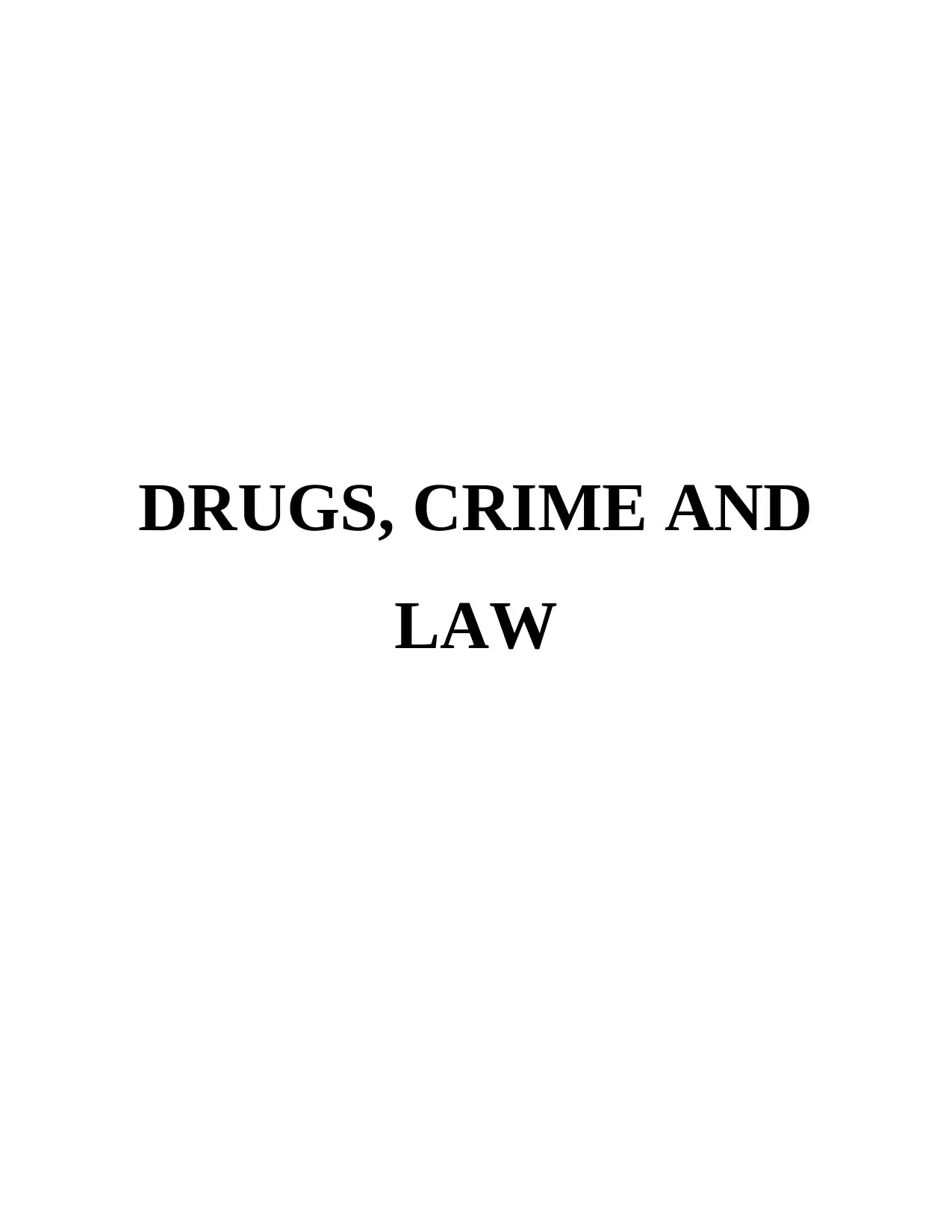
DRUGS, CRIME AND
LAW
LAW
Secure Best Marks with AI Grader
Need help grading? Try our AI Grader for instant feedback on your assignments.
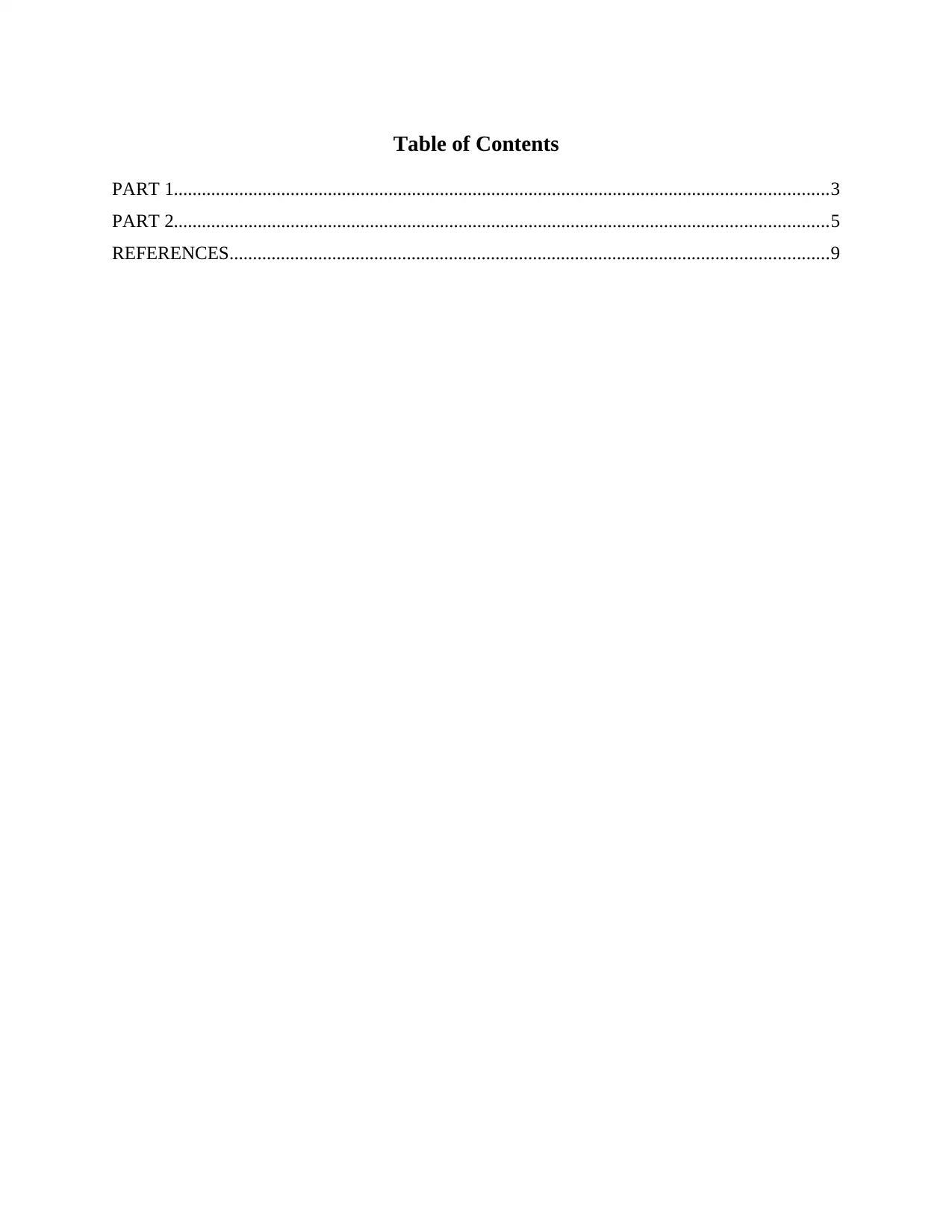
Table of Contents
PART 1............................................................................................................................................3
PART 2............................................................................................................................................5
REFERENCES................................................................................................................................9
PART 1............................................................................................................................................3
PART 2............................................................................................................................................5
REFERENCES................................................................................................................................9
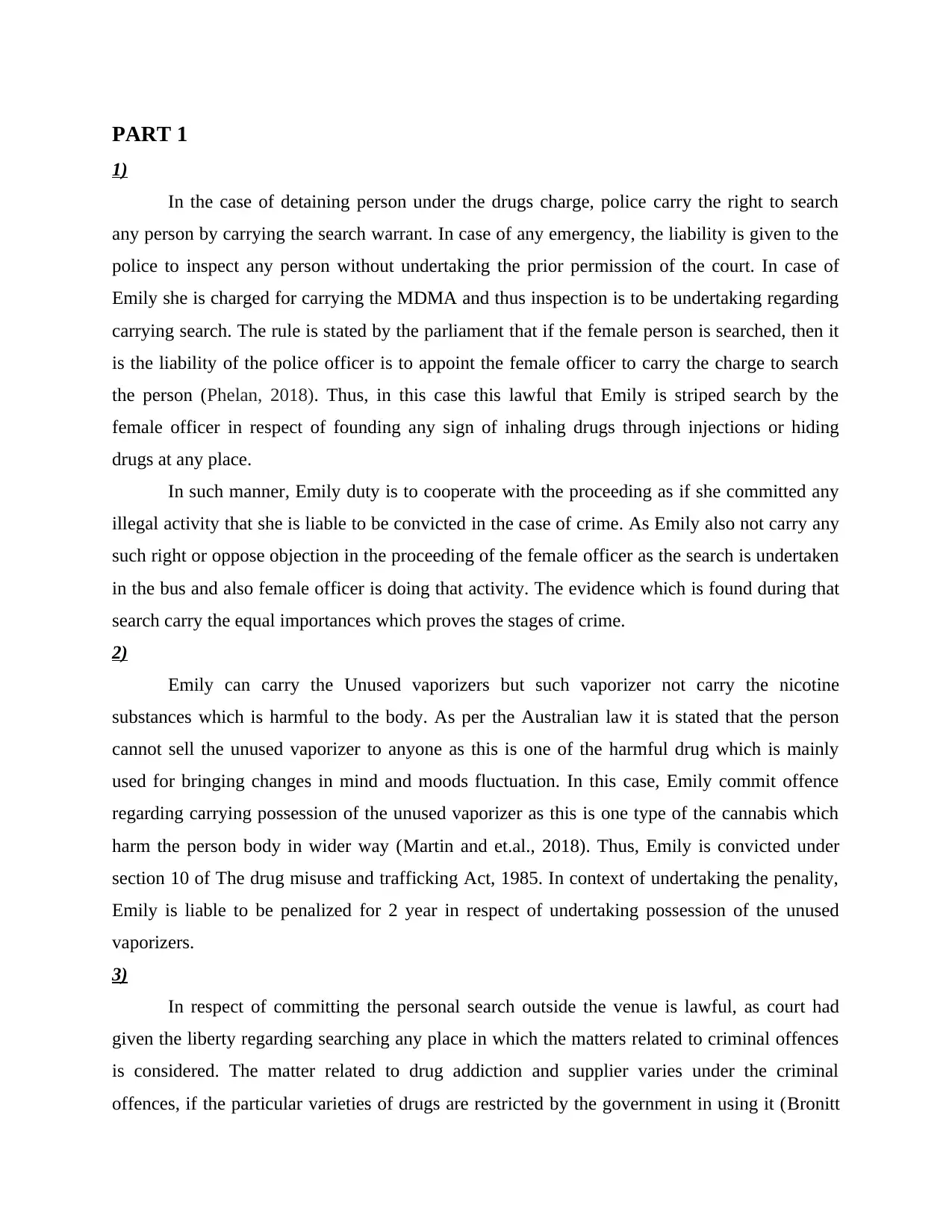
PART 1
1)
In the case of detaining person under the drugs charge, police carry the right to search
any person by carrying the search warrant. In case of any emergency, the liability is given to the
police to inspect any person without undertaking the prior permission of the court. In case of
Emily she is charged for carrying the MDMA and thus inspection is to be undertaking regarding
carrying search. The rule is stated by the parliament that if the female person is searched, then it
is the liability of the police officer is to appoint the female officer to carry the charge to search
the person (Phelan, 2018). Thus, in this case this lawful that Emily is striped search by the
female officer in respect of founding any sign of inhaling drugs through injections or hiding
drugs at any place.
In such manner, Emily duty is to cooperate with the proceeding as if she committed any
illegal activity that she is liable to be convicted in the case of crime. As Emily also not carry any
such right or oppose objection in the proceeding of the female officer as the search is undertaken
in the bus and also female officer is doing that activity. The evidence which is found during that
search carry the equal importances which proves the stages of crime.
2)
Emily can carry the Unused vaporizers but such vaporizer not carry the nicotine
substances which is harmful to the body. As per the Australian law it is stated that the person
cannot sell the unused vaporizer to anyone as this is one of the harmful drug which is mainly
used for bringing changes in mind and moods fluctuation. In this case, Emily commit offence
regarding carrying possession of the unused vaporizer as this is one type of the cannabis which
harm the person body in wider way (Martin and et.al., 2018). Thus, Emily is convicted under
section 10 of The drug misuse and trafficking Act, 1985. In context of undertaking the penality,
Emily is liable to be penalized for 2 year in respect of undertaking possession of the unused
vaporizers.
3)
In respect of committing the personal search outside the venue is lawful, as court had
given the liberty regarding searching any place in which the matters related to criminal offences
is considered. The matter related to drug addiction and supplier varies under the criminal
offences, if the particular varieties of drugs are restricted by the government in using it (Bronitt
1)
In the case of detaining person under the drugs charge, police carry the right to search
any person by carrying the search warrant. In case of any emergency, the liability is given to the
police to inspect any person without undertaking the prior permission of the court. In case of
Emily she is charged for carrying the MDMA and thus inspection is to be undertaking regarding
carrying search. The rule is stated by the parliament that if the female person is searched, then it
is the liability of the police officer is to appoint the female officer to carry the charge to search
the person (Phelan, 2018). Thus, in this case this lawful that Emily is striped search by the
female officer in respect of founding any sign of inhaling drugs through injections or hiding
drugs at any place.
In such manner, Emily duty is to cooperate with the proceeding as if she committed any
illegal activity that she is liable to be convicted in the case of crime. As Emily also not carry any
such right or oppose objection in the proceeding of the female officer as the search is undertaken
in the bus and also female officer is doing that activity. The evidence which is found during that
search carry the equal importances which proves the stages of crime.
2)
Emily can carry the Unused vaporizers but such vaporizer not carry the nicotine
substances which is harmful to the body. As per the Australian law it is stated that the person
cannot sell the unused vaporizer to anyone as this is one of the harmful drug which is mainly
used for bringing changes in mind and moods fluctuation. In this case, Emily commit offence
regarding carrying possession of the unused vaporizer as this is one type of the cannabis which
harm the person body in wider way (Martin and et.al., 2018). Thus, Emily is convicted under
section 10 of The drug misuse and trafficking Act, 1985. In context of undertaking the penality,
Emily is liable to be penalized for 2 year in respect of undertaking possession of the unused
vaporizers.
3)
In respect of committing the personal search outside the venue is lawful, as court had
given the liberty regarding searching any place in which the matters related to criminal offences
is considered. The matter related to drug addiction and supplier varies under the criminal
offences, if the particular varieties of drugs are restricted by the government in using it (Bronitt
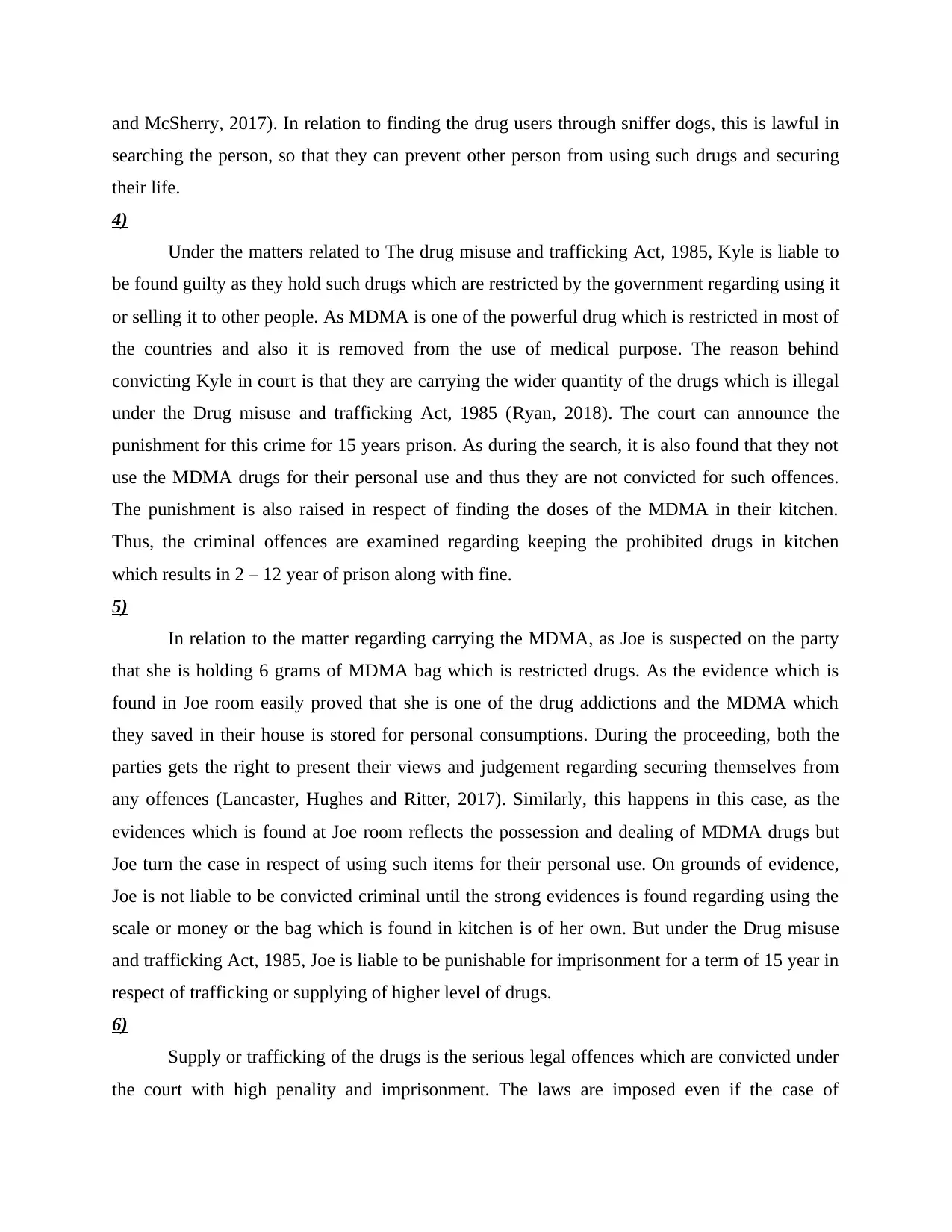
and McSherry, 2017). In relation to finding the drug users through sniffer dogs, this is lawful in
searching the person, so that they can prevent other person from using such drugs and securing
their life.
4)
Under the matters related to The drug misuse and trafficking Act, 1985, Kyle is liable to
be found guilty as they hold such drugs which are restricted by the government regarding using it
or selling it to other people. As MDMA is one of the powerful drug which is restricted in most of
the countries and also it is removed from the use of medical purpose. The reason behind
convicting Kyle in court is that they are carrying the wider quantity of the drugs which is illegal
under the Drug misuse and trafficking Act, 1985 (Ryan, 2018). The court can announce the
punishment for this crime for 15 years prison. As during the search, it is also found that they not
use the MDMA drugs for their personal use and thus they are not convicted for such offences.
The punishment is also raised in respect of finding the doses of the MDMA in their kitchen.
Thus, the criminal offences are examined regarding keeping the prohibited drugs in kitchen
which results in 2 – 12 year of prison along with fine.
5)
In relation to the matter regarding carrying the MDMA, as Joe is suspected on the party
that she is holding 6 grams of MDMA bag which is restricted drugs. As the evidence which is
found in Joe room easily proved that she is one of the drug addictions and the MDMA which
they saved in their house is stored for personal consumptions. During the proceeding, both the
parties gets the right to present their views and judgement regarding securing themselves from
any offences (Lancaster, Hughes and Ritter, 2017). Similarly, this happens in this case, as the
evidences which is found at Joe room reflects the possession and dealing of MDMA drugs but
Joe turn the case in respect of using such items for their personal use. On grounds of evidence,
Joe is not liable to be convicted criminal until the strong evidences is found regarding using the
scale or money or the bag which is found in kitchen is of her own. But under the Drug misuse
and trafficking Act, 1985, Joe is liable to be punishable for imprisonment for a term of 15 year in
respect of trafficking or supplying of higher level of drugs.
6)
Supply or trafficking of the drugs is the serious legal offences which are convicted under
the court with high penality and imprisonment. The laws are imposed even if the case of
searching the person, so that they can prevent other person from using such drugs and securing
their life.
4)
Under the matters related to The drug misuse and trafficking Act, 1985, Kyle is liable to
be found guilty as they hold such drugs which are restricted by the government regarding using it
or selling it to other people. As MDMA is one of the powerful drug which is restricted in most of
the countries and also it is removed from the use of medical purpose. The reason behind
convicting Kyle in court is that they are carrying the wider quantity of the drugs which is illegal
under the Drug misuse and trafficking Act, 1985 (Ryan, 2018). The court can announce the
punishment for this crime for 15 years prison. As during the search, it is also found that they not
use the MDMA drugs for their personal use and thus they are not convicted for such offences.
The punishment is also raised in respect of finding the doses of the MDMA in their kitchen.
Thus, the criminal offences are examined regarding keeping the prohibited drugs in kitchen
which results in 2 – 12 year of prison along with fine.
5)
In relation to the matter regarding carrying the MDMA, as Joe is suspected on the party
that she is holding 6 grams of MDMA bag which is restricted drugs. As the evidence which is
found in Joe room easily proved that she is one of the drug addictions and the MDMA which
they saved in their house is stored for personal consumptions. During the proceeding, both the
parties gets the right to present their views and judgement regarding securing themselves from
any offences (Lancaster, Hughes and Ritter, 2017). Similarly, this happens in this case, as the
evidences which is found at Joe room reflects the possession and dealing of MDMA drugs but
Joe turn the case in respect of using such items for their personal use. On grounds of evidence,
Joe is not liable to be convicted criminal until the strong evidences is found regarding using the
scale or money or the bag which is found in kitchen is of her own. But under the Drug misuse
and trafficking Act, 1985, Joe is liable to be punishable for imprisonment for a term of 15 year in
respect of trafficking or supplying of higher level of drugs.
6)
Supply or trafficking of the drugs is the serious legal offences which are convicted under
the court with high penality and imprisonment. The laws are imposed even if the case of
Secure Best Marks with AI Grader
Need help grading? Try our AI Grader for instant feedback on your assignments.
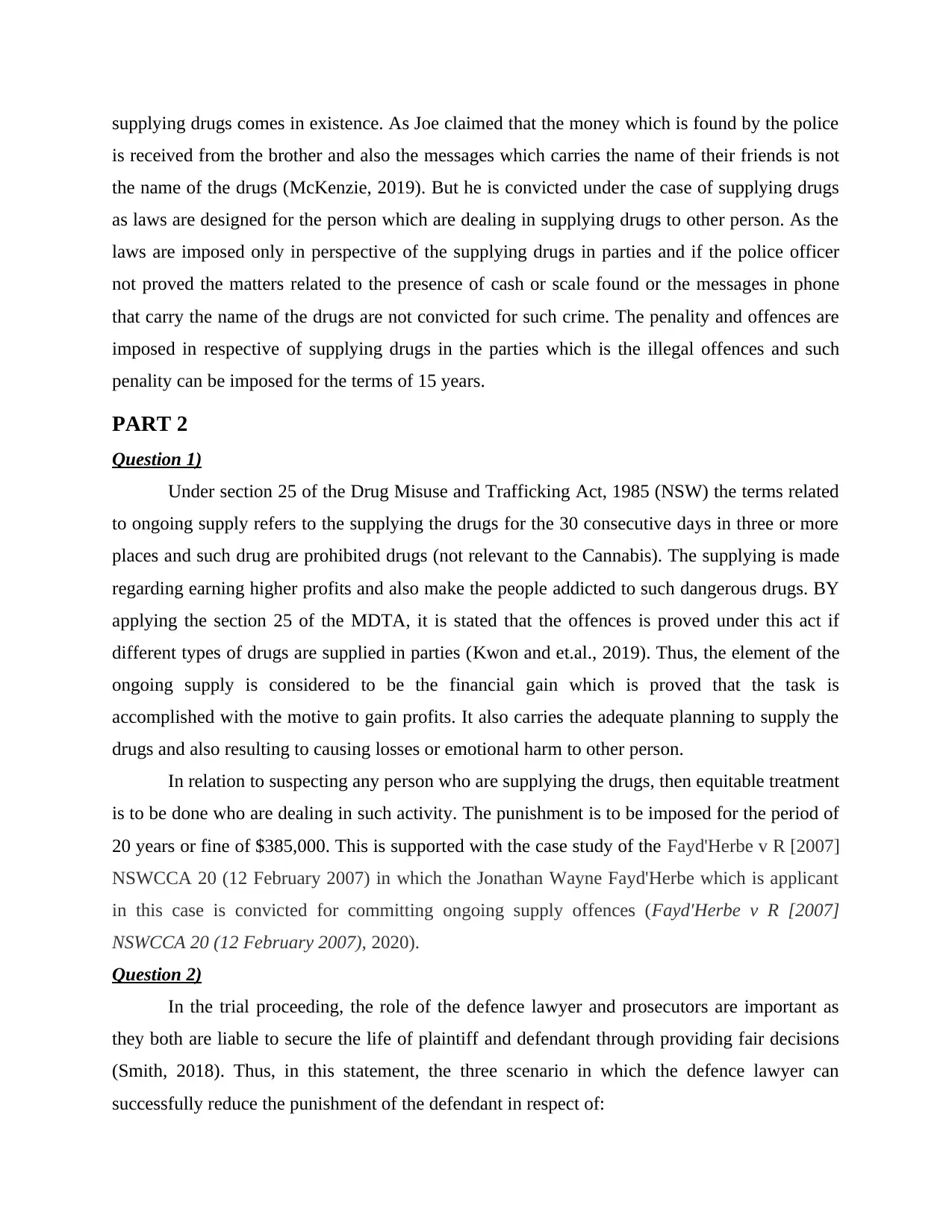
supplying drugs comes in existence. As Joe claimed that the money which is found by the police
is received from the brother and also the messages which carries the name of their friends is not
the name of the drugs (McKenzie, 2019). But he is convicted under the case of supplying drugs
as laws are designed for the person which are dealing in supplying drugs to other person. As the
laws are imposed only in perspective of the supplying drugs in parties and if the police officer
not proved the matters related to the presence of cash or scale found or the messages in phone
that carry the name of the drugs are not convicted for such crime. The penality and offences are
imposed in respective of supplying drugs in the parties which is the illegal offences and such
penality can be imposed for the terms of 15 years.
PART 2
Question 1)
Under section 25 of the Drug Misuse and Trafficking Act, 1985 (NSW) the terms related
to ongoing supply refers to the supplying the drugs for the 30 consecutive days in three or more
places and such drug are prohibited drugs (not relevant to the Cannabis). The supplying is made
regarding earning higher profits and also make the people addicted to such dangerous drugs. BY
applying the section 25 of the MDTA, it is stated that the offences is proved under this act if
different types of drugs are supplied in parties (Kwon and et.al., 2019). Thus, the element of the
ongoing supply is considered to be the financial gain which is proved that the task is
accomplished with the motive to gain profits. It also carries the adequate planning to supply the
drugs and also resulting to causing losses or emotional harm to other person.
In relation to suspecting any person who are supplying the drugs, then equitable treatment
is to be done who are dealing in such activity. The punishment is to be imposed for the period of
20 years or fine of $385,000. This is supported with the case study of the Fayd'Herbe v R [2007]
NSWCCA 20 (12 February 2007) in which the Jonathan Wayne Fayd'Herbe which is applicant
in this case is convicted for committing ongoing supply offences (Fayd'Herbe v R [2007]
NSWCCA 20 (12 February 2007), 2020).
Question 2)
In the trial proceeding, the role of the defence lawyer and prosecutors are important as
they both are liable to secure the life of plaintiff and defendant through providing fair decisions
(Smith, 2018). Thus, in this statement, the three scenario in which the defence lawyer can
successfully reduce the punishment of the defendant in respect of:
is received from the brother and also the messages which carries the name of their friends is not
the name of the drugs (McKenzie, 2019). But he is convicted under the case of supplying drugs
as laws are designed for the person which are dealing in supplying drugs to other person. As the
laws are imposed only in perspective of the supplying drugs in parties and if the police officer
not proved the matters related to the presence of cash or scale found or the messages in phone
that carry the name of the drugs are not convicted for such crime. The penality and offences are
imposed in respective of supplying drugs in the parties which is the illegal offences and such
penality can be imposed for the terms of 15 years.
PART 2
Question 1)
Under section 25 of the Drug Misuse and Trafficking Act, 1985 (NSW) the terms related
to ongoing supply refers to the supplying the drugs for the 30 consecutive days in three or more
places and such drug are prohibited drugs (not relevant to the Cannabis). The supplying is made
regarding earning higher profits and also make the people addicted to such dangerous drugs. BY
applying the section 25 of the MDTA, it is stated that the offences is proved under this act if
different types of drugs are supplied in parties (Kwon and et.al., 2019). Thus, the element of the
ongoing supply is considered to be the financial gain which is proved that the task is
accomplished with the motive to gain profits. It also carries the adequate planning to supply the
drugs and also resulting to causing losses or emotional harm to other person.
In relation to suspecting any person who are supplying the drugs, then equitable treatment
is to be done who are dealing in such activity. The punishment is to be imposed for the period of
20 years or fine of $385,000. This is supported with the case study of the Fayd'Herbe v R [2007]
NSWCCA 20 (12 February 2007) in which the Jonathan Wayne Fayd'Herbe which is applicant
in this case is convicted for committing ongoing supply offences (Fayd'Herbe v R [2007]
NSWCCA 20 (12 February 2007), 2020).
Question 2)
In the trial proceeding, the role of the defence lawyer and prosecutors are important as
they both are liable to secure the life of plaintiff and defendant through providing fair decisions
(Smith, 2018). Thus, in this statement, the three scenario in which the defence lawyer can
successfully reduce the punishment of the defendant in respect of:
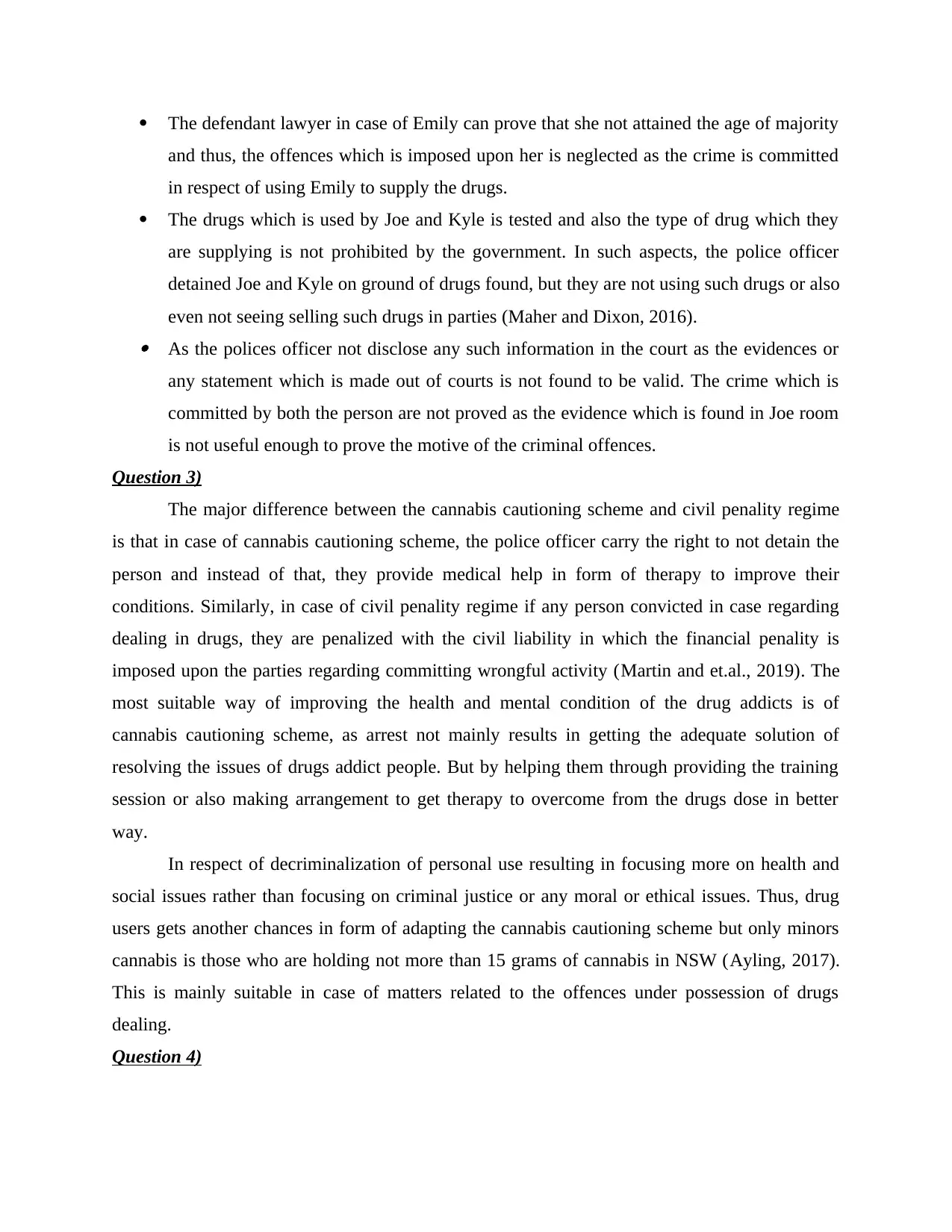
The defendant lawyer in case of Emily can prove that she not attained the age of majority
and thus, the offences which is imposed upon her is neglected as the crime is committed
in respect of using Emily to supply the drugs.
The drugs which is used by Joe and Kyle is tested and also the type of drug which they
are supplying is not prohibited by the government. In such aspects, the police officer
detained Joe and Kyle on ground of drugs found, but they are not using such drugs or also
even not seeing selling such drugs in parties (Maher and Dixon, 2016). As the polices officer not disclose any such information in the court as the evidences or
any statement which is made out of courts is not found to be valid. The crime which is
committed by both the person are not proved as the evidence which is found in Joe room
is not useful enough to prove the motive of the criminal offences.
Question 3)
The major difference between the cannabis cautioning scheme and civil penality regime
is that in case of cannabis cautioning scheme, the police officer carry the right to not detain the
person and instead of that, they provide medical help in form of therapy to improve their
conditions. Similarly, in case of civil penality regime if any person convicted in case regarding
dealing in drugs, they are penalized with the civil liability in which the financial penality is
imposed upon the parties regarding committing wrongful activity (Martin and et.al., 2019). The
most suitable way of improving the health and mental condition of the drug addicts is of
cannabis cautioning scheme, as arrest not mainly results in getting the adequate solution of
resolving the issues of drugs addict people. But by helping them through providing the training
session or also making arrangement to get therapy to overcome from the drugs dose in better
way.
In respect of decriminalization of personal use resulting in focusing more on health and
social issues rather than focusing on criminal justice or any moral or ethical issues. Thus, drug
users gets another chances in form of adapting the cannabis cautioning scheme but only minors
cannabis is those who are holding not more than 15 grams of cannabis in NSW (Ayling, 2017).
This is mainly suitable in case of matters related to the offences under possession of drugs
dealing.
Question 4)
and thus, the offences which is imposed upon her is neglected as the crime is committed
in respect of using Emily to supply the drugs.
The drugs which is used by Joe and Kyle is tested and also the type of drug which they
are supplying is not prohibited by the government. In such aspects, the police officer
detained Joe and Kyle on ground of drugs found, but they are not using such drugs or also
even not seeing selling such drugs in parties (Maher and Dixon, 2016). As the polices officer not disclose any such information in the court as the evidences or
any statement which is made out of courts is not found to be valid. The crime which is
committed by both the person are not proved as the evidence which is found in Joe room
is not useful enough to prove the motive of the criminal offences.
Question 3)
The major difference between the cannabis cautioning scheme and civil penality regime
is that in case of cannabis cautioning scheme, the police officer carry the right to not detain the
person and instead of that, they provide medical help in form of therapy to improve their
conditions. Similarly, in case of civil penality regime if any person convicted in case regarding
dealing in drugs, they are penalized with the civil liability in which the financial penality is
imposed upon the parties regarding committing wrongful activity (Martin and et.al., 2019). The
most suitable way of improving the health and mental condition of the drug addicts is of
cannabis cautioning scheme, as arrest not mainly results in getting the adequate solution of
resolving the issues of drugs addict people. But by helping them through providing the training
session or also making arrangement to get therapy to overcome from the drugs dose in better
way.
In respect of decriminalization of personal use resulting in focusing more on health and
social issues rather than focusing on criminal justice or any moral or ethical issues. Thus, drug
users gets another chances in form of adapting the cannabis cautioning scheme but only minors
cannabis is those who are holding not more than 15 grams of cannabis in NSW (Ayling, 2017).
This is mainly suitable in case of matters related to the offences under possession of drugs
dealing.
Question 4)
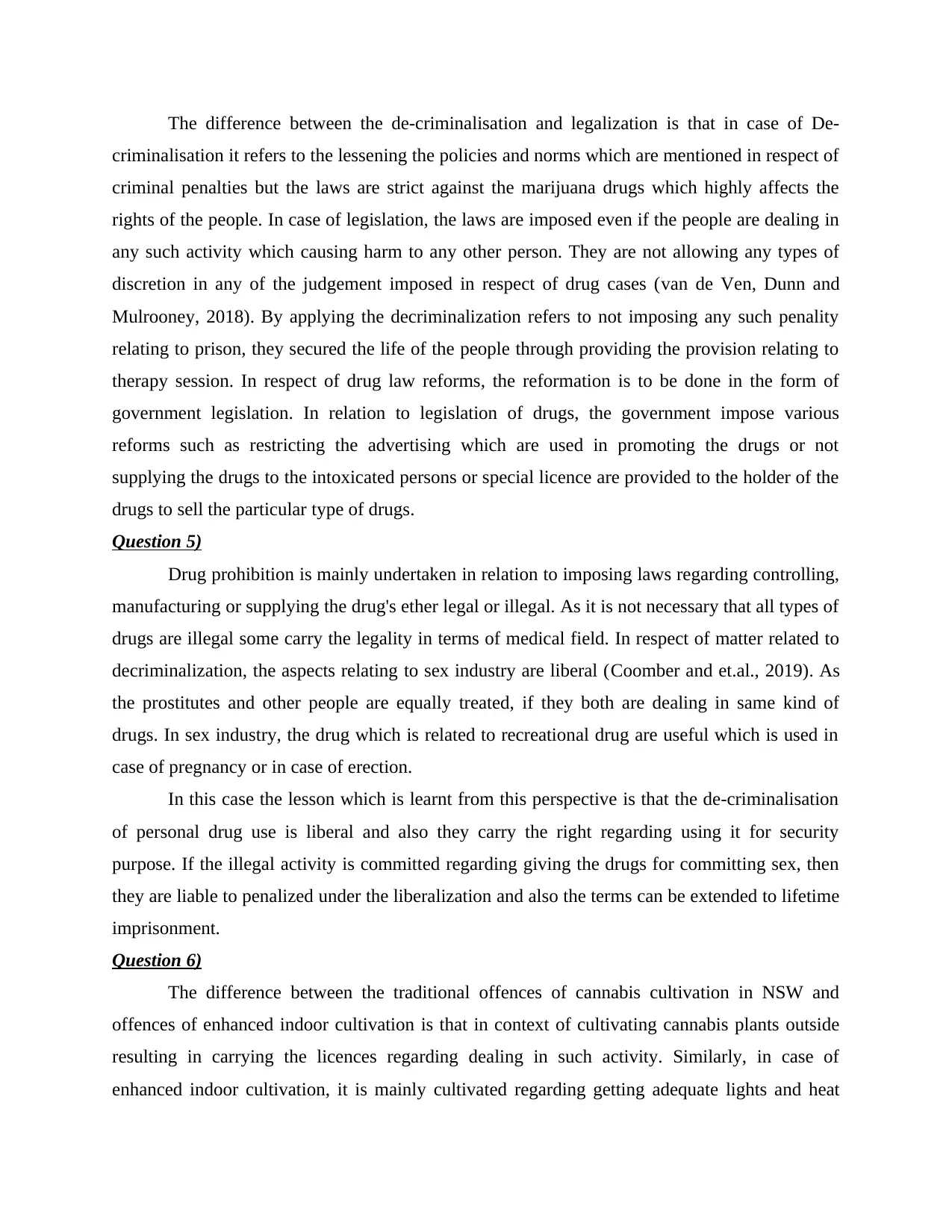
The difference between the de-criminalisation and legalization is that in case of De-
criminalisation it refers to the lessening the policies and norms which are mentioned in respect of
criminal penalties but the laws are strict against the marijuana drugs which highly affects the
rights of the people. In case of legislation, the laws are imposed even if the people are dealing in
any such activity which causing harm to any other person. They are not allowing any types of
discretion in any of the judgement imposed in respect of drug cases (van de Ven, Dunn and
Mulrooney, 2018). By applying the decriminalization refers to not imposing any such penality
relating to prison, they secured the life of the people through providing the provision relating to
therapy session. In respect of drug law reforms, the reformation is to be done in the form of
government legislation. In relation to legislation of drugs, the government impose various
reforms such as restricting the advertising which are used in promoting the drugs or not
supplying the drugs to the intoxicated persons or special licence are provided to the holder of the
drugs to sell the particular type of drugs.
Question 5)
Drug prohibition is mainly undertaken in relation to imposing laws regarding controlling,
manufacturing or supplying the drug's ether legal or illegal. As it is not necessary that all types of
drugs are illegal some carry the legality in terms of medical field. In respect of matter related to
decriminalization, the aspects relating to sex industry are liberal (Coomber and et.al., 2019). As
the prostitutes and other people are equally treated, if they both are dealing in same kind of
drugs. In sex industry, the drug which is related to recreational drug are useful which is used in
case of pregnancy or in case of erection.
In this case the lesson which is learnt from this perspective is that the de-criminalisation
of personal drug use is liberal and also they carry the right regarding using it for security
purpose. If the illegal activity is committed regarding giving the drugs for committing sex, then
they are liable to penalized under the liberalization and also the terms can be extended to lifetime
imprisonment.
Question 6)
The difference between the traditional offences of cannabis cultivation in NSW and
offences of enhanced indoor cultivation is that in context of cultivating cannabis plants outside
resulting in carrying the licences regarding dealing in such activity. Similarly, in case of
enhanced indoor cultivation, it is mainly cultivated regarding getting adequate lights and heat
criminalisation it refers to the lessening the policies and norms which are mentioned in respect of
criminal penalties but the laws are strict against the marijuana drugs which highly affects the
rights of the people. In case of legislation, the laws are imposed even if the people are dealing in
any such activity which causing harm to any other person. They are not allowing any types of
discretion in any of the judgement imposed in respect of drug cases (van de Ven, Dunn and
Mulrooney, 2018). By applying the decriminalization refers to not imposing any such penality
relating to prison, they secured the life of the people through providing the provision relating to
therapy session. In respect of drug law reforms, the reformation is to be done in the form of
government legislation. In relation to legislation of drugs, the government impose various
reforms such as restricting the advertising which are used in promoting the drugs or not
supplying the drugs to the intoxicated persons or special licence are provided to the holder of the
drugs to sell the particular type of drugs.
Question 5)
Drug prohibition is mainly undertaken in relation to imposing laws regarding controlling,
manufacturing or supplying the drug's ether legal or illegal. As it is not necessary that all types of
drugs are illegal some carry the legality in terms of medical field. In respect of matter related to
decriminalization, the aspects relating to sex industry are liberal (Coomber and et.al., 2019). As
the prostitutes and other people are equally treated, if they both are dealing in same kind of
drugs. In sex industry, the drug which is related to recreational drug are useful which is used in
case of pregnancy or in case of erection.
In this case the lesson which is learnt from this perspective is that the de-criminalisation
of personal drug use is liberal and also they carry the right regarding using it for security
purpose. If the illegal activity is committed regarding giving the drugs for committing sex, then
they are liable to penalized under the liberalization and also the terms can be extended to lifetime
imprisonment.
Question 6)
The difference between the traditional offences of cannabis cultivation in NSW and
offences of enhanced indoor cultivation is that in context of cultivating cannabis plants outside
resulting in carrying the licences regarding dealing in such activity. Similarly, in case of
enhanced indoor cultivation, it is mainly cultivated regarding getting adequate lights and heat
Paraphrase This Document
Need a fresh take? Get an instant paraphrase of this document with our AI Paraphraser
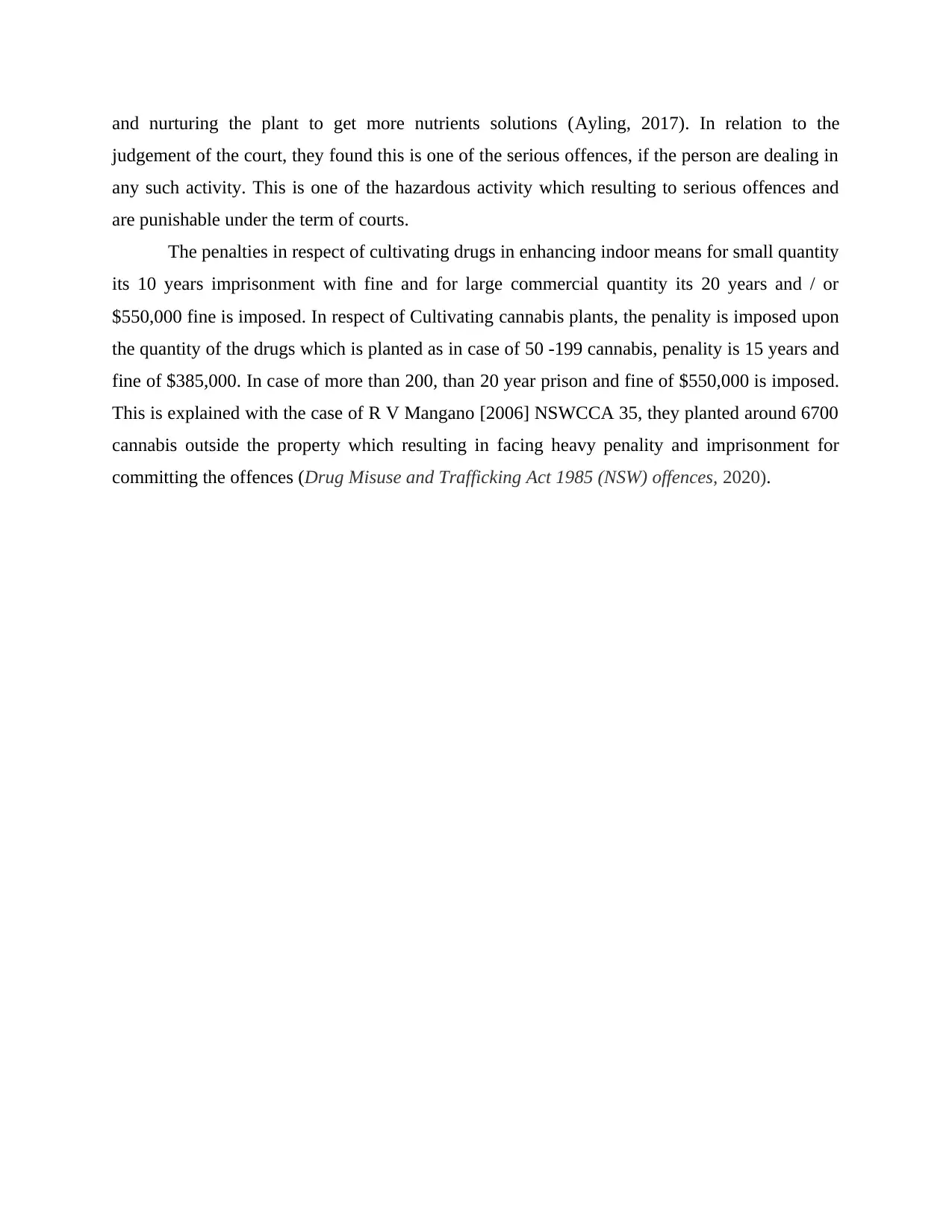
and nurturing the plant to get more nutrients solutions (Ayling, 2017). In relation to the
judgement of the court, they found this is one of the serious offences, if the person are dealing in
any such activity. This is one of the hazardous activity which resulting to serious offences and
are punishable under the term of courts.
The penalties in respect of cultivating drugs in enhancing indoor means for small quantity
its 10 years imprisonment with fine and for large commercial quantity its 20 years and / or
$550,000 fine is imposed. In respect of Cultivating cannabis plants, the penality is imposed upon
the quantity of the drugs which is planted as in case of 50 -199 cannabis, penality is 15 years and
fine of $385,000. In case of more than 200, than 20 year prison and fine of $550,000 is imposed.
This is explained with the case of R V Mangano [2006] NSWCCA 35, they planted around 6700
cannabis outside the property which resulting in facing heavy penality and imprisonment for
committing the offences (Drug Misuse and Trafficking Act 1985 (NSW) offences, 2020).
judgement of the court, they found this is one of the serious offences, if the person are dealing in
any such activity. This is one of the hazardous activity which resulting to serious offences and
are punishable under the term of courts.
The penalties in respect of cultivating drugs in enhancing indoor means for small quantity
its 10 years imprisonment with fine and for large commercial quantity its 20 years and / or
$550,000 fine is imposed. In respect of Cultivating cannabis plants, the penality is imposed upon
the quantity of the drugs which is planted as in case of 50 -199 cannabis, penality is 15 years and
fine of $385,000. In case of more than 200, than 20 year prison and fine of $550,000 is imposed.
This is explained with the case of R V Mangano [2006] NSWCCA 35, they planted around 6700
cannabis outside the property which resulting in facing heavy penality and imprisonment for
committing the offences (Drug Misuse and Trafficking Act 1985 (NSW) offences, 2020).
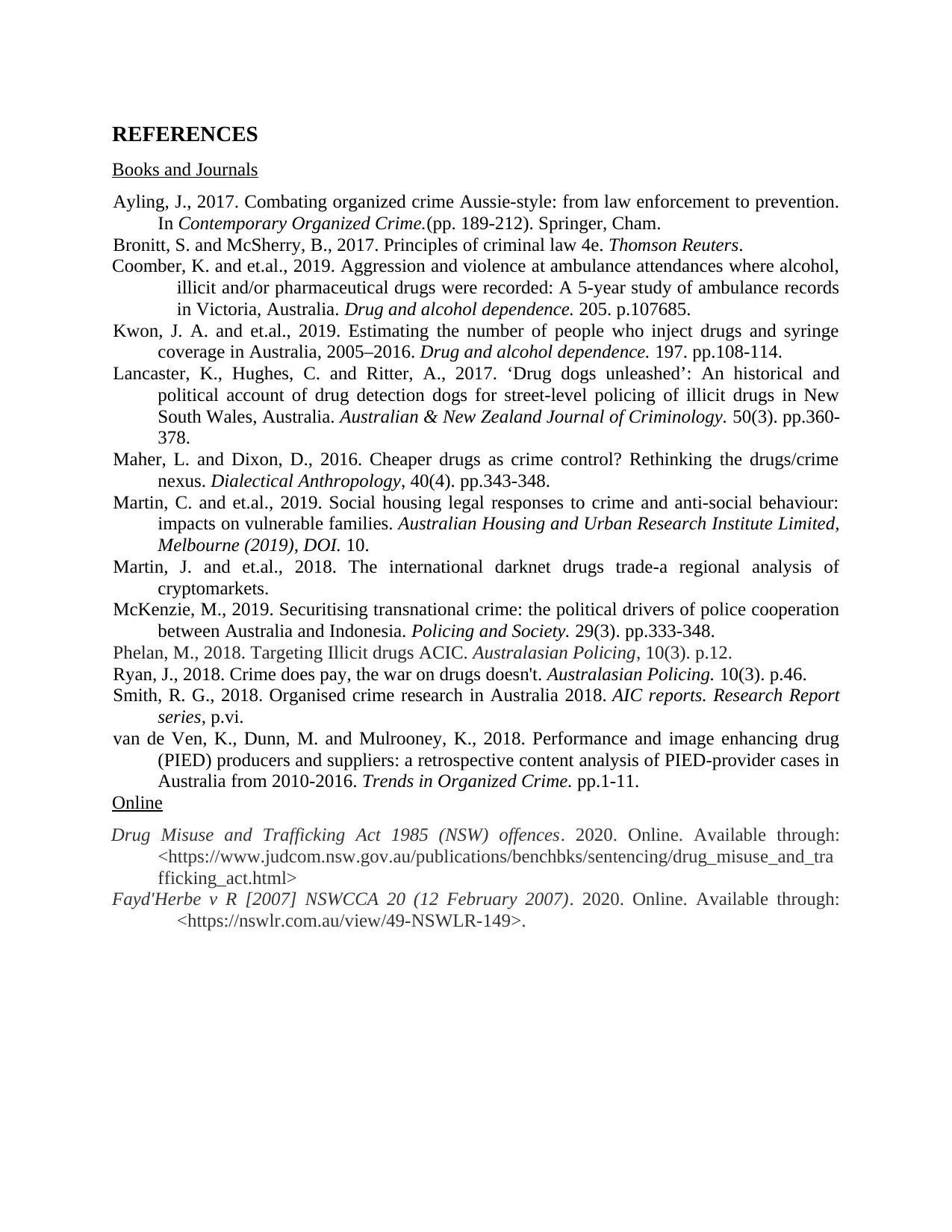
REFERENCES
Books and Journals
Ayling, J., 2017. Combating organized crime Aussie-style: from law enforcement to prevention.
In Contemporary Organized Crime.(pp. 189-212). Springer, Cham.
Bronitt, S. and McSherry, B., 2017. Principles of criminal law 4e. Thomson Reuters.
Coomber, K. and et.al., 2019. Aggression and violence at ambulance attendances where alcohol,
illicit and/or pharmaceutical drugs were recorded: A 5-year study of ambulance records
in Victoria, Australia. Drug and alcohol dependence. 205. p.107685.
Kwon, J. A. and et.al., 2019. Estimating the number of people who inject drugs and syringe
coverage in Australia, 2005–2016. Drug and alcohol dependence. 197. pp.108-114.
Lancaster, K., Hughes, C. and Ritter, A., 2017. ‘Drug dogs unleashed’: An historical and
political account of drug detection dogs for street-level policing of illicit drugs in New
South Wales, Australia. Australian & New Zealand Journal of Criminology. 50(3). pp.360-
378.
Maher, L. and Dixon, D., 2016. Cheaper drugs as crime control? Rethinking the drugs/crime
nexus. Dialectical Anthropology, 40(4). pp.343-348.
Martin, C. and et.al., 2019. Social housing legal responses to crime and anti-social behaviour:
impacts on vulnerable families. Australian Housing and Urban Research Institute Limited,
Melbourne (2019), DOI. 10.
Martin, J. and et.al., 2018. The international darknet drugs trade-a regional analysis of
cryptomarkets.
McKenzie, M., 2019. Securitising transnational crime: the political drivers of police cooperation
between Australia and Indonesia. Policing and Society. 29(3). pp.333-348.
Phelan, M., 2018. Targeting Illicit drugs ACIC. Australasian Policing, 10(3). p.12.
Ryan, J., 2018. Crime does pay, the war on drugs doesn't. Australasian Policing. 10(3). p.46.
Smith, R. G., 2018. Organised crime research in Australia 2018. AIC reports. Research Report
series, p.vi.
van de Ven, K., Dunn, M. and Mulrooney, K., 2018. Performance and image enhancing drug
(PIED) producers and suppliers: a retrospective content analysis of PIED-provider cases in
Australia from 2010-2016. Trends in Organized Crime. pp.1-11.
Online
Drug Misuse and Trafficking Act 1985 (NSW) offences. 2020. Online. Available through:
<https://www.judcom.nsw.gov.au/publications/benchbks/sentencing/drug_misuse_and_tra
fficking_act.html>
Fayd'Herbe v R [2007] NSWCCA 20 (12 February 2007). 2020. Online. Available through:
<https://nswlr.com.au/view/49-NSWLR-149>.
Books and Journals
Ayling, J., 2017. Combating organized crime Aussie-style: from law enforcement to prevention.
In Contemporary Organized Crime.(pp. 189-212). Springer, Cham.
Bronitt, S. and McSherry, B., 2017. Principles of criminal law 4e. Thomson Reuters.
Coomber, K. and et.al., 2019. Aggression and violence at ambulance attendances where alcohol,
illicit and/or pharmaceutical drugs were recorded: A 5-year study of ambulance records
in Victoria, Australia. Drug and alcohol dependence. 205. p.107685.
Kwon, J. A. and et.al., 2019. Estimating the number of people who inject drugs and syringe
coverage in Australia, 2005–2016. Drug and alcohol dependence. 197. pp.108-114.
Lancaster, K., Hughes, C. and Ritter, A., 2017. ‘Drug dogs unleashed’: An historical and
political account of drug detection dogs for street-level policing of illicit drugs in New
South Wales, Australia. Australian & New Zealand Journal of Criminology. 50(3). pp.360-
378.
Maher, L. and Dixon, D., 2016. Cheaper drugs as crime control? Rethinking the drugs/crime
nexus. Dialectical Anthropology, 40(4). pp.343-348.
Martin, C. and et.al., 2019. Social housing legal responses to crime and anti-social behaviour:
impacts on vulnerable families. Australian Housing and Urban Research Institute Limited,
Melbourne (2019), DOI. 10.
Martin, J. and et.al., 2018. The international darknet drugs trade-a regional analysis of
cryptomarkets.
McKenzie, M., 2019. Securitising transnational crime: the political drivers of police cooperation
between Australia and Indonesia. Policing and Society. 29(3). pp.333-348.
Phelan, M., 2018. Targeting Illicit drugs ACIC. Australasian Policing, 10(3). p.12.
Ryan, J., 2018. Crime does pay, the war on drugs doesn't. Australasian Policing. 10(3). p.46.
Smith, R. G., 2018. Organised crime research in Australia 2018. AIC reports. Research Report
series, p.vi.
van de Ven, K., Dunn, M. and Mulrooney, K., 2018. Performance and image enhancing drug
(PIED) producers and suppliers: a retrospective content analysis of PIED-provider cases in
Australia from 2010-2016. Trends in Organized Crime. pp.1-11.
Online
Drug Misuse and Trafficking Act 1985 (NSW) offences. 2020. Online. Available through:
<https://www.judcom.nsw.gov.au/publications/benchbks/sentencing/drug_misuse_and_tra
fficking_act.html>
Fayd'Herbe v R [2007] NSWCCA 20 (12 February 2007). 2020. Online. Available through:
<https://nswlr.com.au/view/49-NSWLR-149>.
1 out of 9
Related Documents
Your All-in-One AI-Powered Toolkit for Academic Success.
+13062052269
info@desklib.com
Available 24*7 on WhatsApp / Email
![[object Object]](/_next/static/media/star-bottom.7253800d.svg)
Unlock your academic potential
© 2024 | Zucol Services PVT LTD | All rights reserved.





